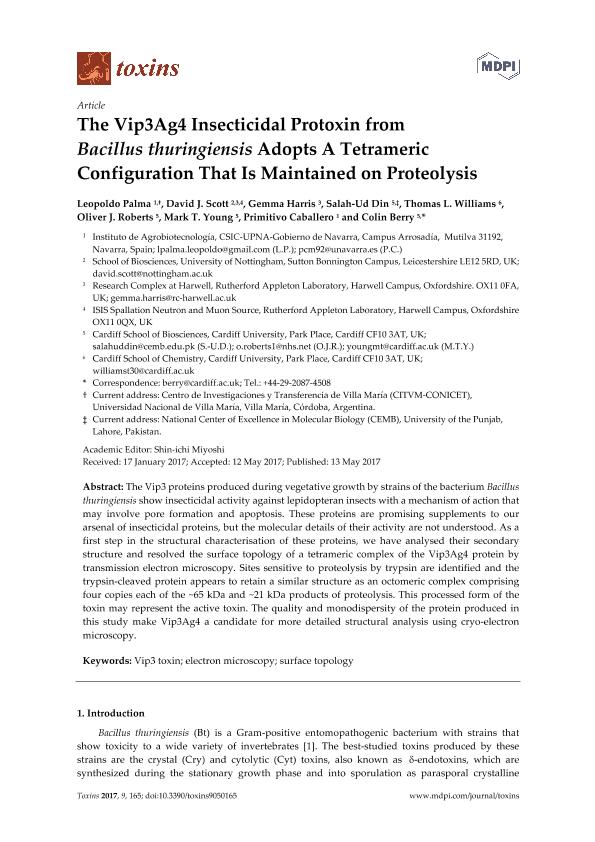Mostrar el registro sencillo del ítem
dc.contributor.author
Palma, Leopoldo

dc.contributor.author
Scott, David J.
dc.contributor.author
Harris, Gemma
dc.contributor.author
Din, Salah-Ud
dc.contributor.author
Williams, Thomas L.
dc.contributor.author
Roberts, Oliver J.
dc.contributor.author
Young, Mark T.
dc.contributor.author
Caballero, Primitivo
dc.contributor.author
Berry, Colin
dc.date.available
2019-05-23T15:33:04Z
dc.date.issued
2017-05
dc.identifier.citation
Palma, Leopoldo; Scott, David J.; Harris, Gemma; Din, Salah-Ud; Williams, Thomas L.; et al.; The Vip3Ag4 insecticidal protoxin from Bacillus thuringiensis adopts a tetrameric configuration that is maintained on proteolysis; MDPI AG; Toxins; 9; 5; 5-2017
dc.identifier.issn
2072-6651
dc.identifier.uri
http://hdl.handle.net/11336/76942
dc.description.abstract
The Vip3 proteins produced during vegetative growth by strains of the bacterium Bacillus thuringiensis show insecticidal activity against lepidopteran insects with a mechanism of action that may involve pore formation and apoptosis. These proteins are promising supplements to our arsenal of insecticidal proteins, but the molecular details of their activity are not understood. As a first step in the structural characterisation of these proteins, we have analysed their secondary structure and resolved the surface topology of a tetrameric complex of the Vip3Ag4 protein by transmission electron microscopy. Sites sensitive to proteolysis by trypsin are identified and the trypsin-cleaved protein appears to retain a similar structure as an octomeric complex comprising four copies each of the ~65 kDa and ~21 kDa products of proteolysis. This processed form of the toxin may represent the active toxin. The quality and monodispersity of the protein produced in this study make Vip3Ag4 a candidate for more detailed structural analysis using cryo-electron microscopy.
dc.format
application/pdf
dc.language.iso
eng
dc.publisher
MDPI AG
dc.rights
info:eu-repo/semantics/openAccess
dc.rights.uri
https://creativecommons.org/licenses/by-nc-sa/2.5/ar/
dc.subject
Bacillus Thuringiensis
dc.subject
Vegetative Insecticidal Protein
dc.subject
Toxins Structure
dc.subject
Mode of Action
dc.subject.classification
Otras Ciencias Biológicas

dc.subject.classification
Ciencias Biológicas

dc.subject.classification
CIENCIAS NATURALES Y EXACTAS

dc.title
The Vip3Ag4 insecticidal protoxin from Bacillus thuringiensis adopts a tetrameric configuration that is maintained on proteolysis
dc.type
info:eu-repo/semantics/article
dc.type
info:ar-repo/semantics/artículo
dc.type
info:eu-repo/semantics/publishedVersion
dc.date.updated
2019-05-23T14:39:02Z
dc.identifier.eissn
2072-6651
dc.journal.volume
9
dc.journal.number
5
dc.journal.pais
Suiza

dc.journal.ciudad
Basel
dc.description.fil
Fil: Palma, Leopoldo. Consejo Nacional de Investigaciones Científicas y Técnicas. Centro Científico Tecnológico Conicet - Córdoba. Centro de Investigaciones y Transferencia de Villa María. Universidad Nacional de Villa María. Centro de Investigaciones y Transferencia de Villa María; Argentina
dc.description.fil
Fil: Scott, David J.. Science and Technology Facilities Council of Nottingham. Rutherford Appleton Laboratory; Reino Unido. University of Nottingham; Estados Unidos
dc.description.fil
Fil: Harris, Gemma. University of Nottingham; Estados Unidos
dc.description.fil
Fil: Din, Salah-Ud. Cardiff University; Reino Unido
dc.description.fil
Fil: Williams, Thomas L.. Cardiff University; Reino Unido
dc.description.fil
Fil: Roberts, Oliver J.. Cardiff University; Reino Unido
dc.description.fil
Fil: Young, Mark T.. Cardiff University; Reino Unido
dc.description.fil
Fil: Caballero, Primitivo. Universidad de Navarra; España
dc.description.fil
Fil: Berry, Colin. Cardiff University; Reino Unido
dc.journal.title
Toxins
dc.relation.alternativeid
info:eu-repo/semantics/altIdentifier/url/https://www.mdpi.com/2072-6651/9/5/165
dc.relation.alternativeid
info:eu-repo/semantics/altIdentifier/doi/http://dx.doi.org/10.3390/toxins9050165
Archivos asociados
